How the US-China trade talks hit a wall
Frustration and miscalculations marred US-China talks. Hopes now rest on a Trump-Xi meeting.
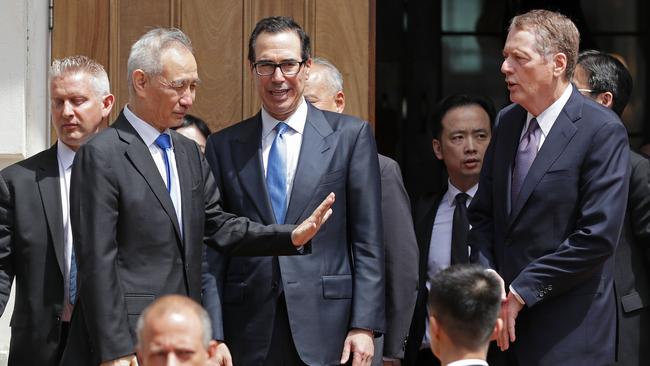
The US and Chinese governments both sent signals ahead of their trade talks in Washington last week that a pact was so near they would discuss the logistics of a signing ceremony.
In a matter of days, the dynamic shifted so markedly that the Chinese deliberated whether to even show up after President Donald Trump ordered a last-minute increase in tariffs on Chinese imports because the US viewed China as reneging on previous commitments.
Inside the cloistered Zhongnanhai government compound in Beijing, President Xi Jinping and his close advisers discussed how to respond to the tariff increase, given the talks were just days away, according to Chinese officials with knowledge of the decision-making process.
After huddling on Tuesday to analyse a press conference given by the US’s two top negotiators, Treasury Secretary Steven Mnuchin and US Trade Representative Robert Lighthizer, Chinese officials concluded that they should travel to at least avoid a rift that could be difficult to repair.
The recommendation went to China’s chief negotiator, Liu He, and ultimately to Mr Xi. He decided to send the team even though Beijing was fully aware that the trip held little prospect of progress, given how quickly problems had arisen. “The goal was simply to keep the talks going,” said one of the Chinese officials with knowledge of the matter.
By the end of the week, that was as much as both sides could cite for their efforts: the avoidance of a serious rupture that would doom any prospect of a future deal and a commitment to stay near the negotiating table.
....We will then spend (match or better) the money that China may no longer be spending with our Great Patriot Farmers (Agriculture), which is a small percentage of total Tariffs received, and distribute the food to starving people in nations around the world! GREAT! #MAGA
— Donald J. Trump (@realDonaldTrump) May 12, 2019
So far, the trade talks have provided little evidence that the two nations have found a formula for how to negotiate successfully since Mr Trump and Mr Xi met in Buenos Aires on December 1, which paved the way to Washington last week.
China didn’t immediately impose new strictures on US businesses, as it has done when things weren’t going well in the past. Mr Liu is expected to brief Mr Xi on the discussions he had in Washington before Beijing decides on the next course of action, according to the officials familiar with the process.
On Sunday, White House economics adviser Larry Kudlow said in an interview on Fox News Sunday that China has invited Mr Lighthizer and Mr Mnuchin to Beijing to continue trade negotiations, but that there were “no concrete, definite plans yet.”
Mr Kudlow suggested one possible way out. He stressed twice during the Fox News interview that the American and Chinese presidents expect to meet again at the next G-20 in Japan at the end of June.
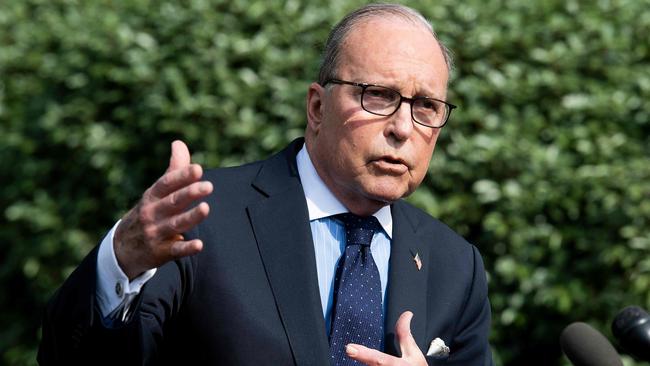
Bridging the trade rift may ultimately depend on the personal chemistry between President Trump and President Xi and their willingness to push matters forward after months of negotiations that have been full of positive intentions but thwarted by miscalculations, accusations of backtracking and unfulfilled expectations.
At stake are the rules for global trade in a world order up-ended by China’s rapid rise, and both sides are keen to project an image of strength. The longer the dispute lingers, though, the greater the risk of economic fallout for both countries, along with prolonged uncertainty for global stock markets, which have whipsawed as expectations for a deal ebb and flow. The accelerating 2020 presidential campaign also promises to add a volatile new dynamic to the equation.
An eventual trade pact could give the US and China momentum and a possible key to rapprochement on a number of other tense fronts, from the US campaign against Huawei Technologies over security concerns in the telecommunications industry to navigating rights in the South China Sea.
After the Trump-Xi meeting in Argentina, on the sidelines of the G-20 conclave, the US said it would suspend increasing tariffs from 10 per cent to 25 per cent until March 1 if American concerns were met. As that date approached, Mr Trump made the suspension indefinite. His patience ran out May 5, when he tweeted tariffs would rise five days later. The increased tariffs on $US200 billion of Chinese goods took effect Friday.
Throughout the negotiations, there have been tensions all along the way. US officials complained in February that China was reneging on previously agreed items, the same dynamic that resurfaced in recent days.
“They were playing games with us,” said one senior US trade official of the talks in Washington three months ago. Mr Kudlow told reporters at the time that Mr. Lighthizer “read them the riot act.”
“The more heated moments have been in situations where we thought we had something and suddenly there was some backsliding,” said one person involved in the discussions on the US side.
“We’ve expressed some pretty serious frustration at times,” this person said. “It’s been a necessary ingredient to success. You can be nice to someone, but sometimes you need to say ‘stop screwing me.’ “
In early April, Mr Mnuchin announced that negotiators had agreed on a mechanism for enforcing the terms of their potential trade deal, suggesting one of the key stumbling blocks toward an accord had been cleared, although Beijing never agreed that the issue had been settled.
Then, before travelling to Beijing for another round of talks, Mr Mnuchin said that the trade talks were “getting close to the final round of concluding issues.” After, as he and Mr Lighthizer prepared to board the jet home, he tweeted on May 1 that the meetings had been “productive.” Mr Lighthizer shared that assessment, even though he and Mr Mnuchin have often held differing views on China, according to people tracking the talks.
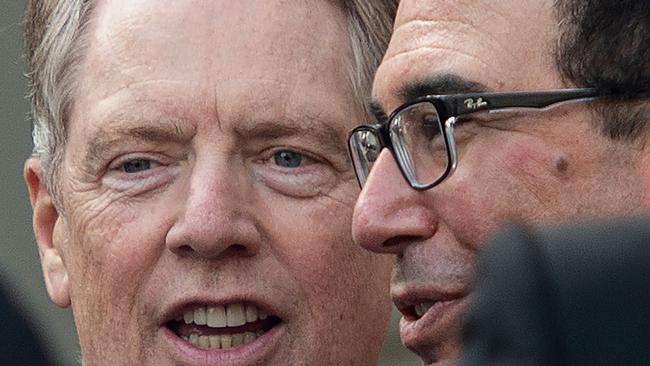
Mr Lighthizer is a longtime China hawk who has taken the line that the US needs to stand firm in pushing for better access for US companies in China and in confronting the Chinese over practices such as the theft of intellectual property. People close to Mr Mnuchin say he shares the goal of changing the rules of trade but is concerned about potential fallout on financial markets from the lingering uncertainty.
“We were in the process of planning for a signing summit with President Trump and President Xi upon the completion of this agreement,” Mr Mnuchin later told reporters. One of the issues was where to hold the celebratory moment: Washington or Mr Trump’s golf estates in Mar-a-Lago, in Florida, or Bedminster, New Jersey, say Trump aides.
Several current and former White House officials say they viewed Mr Mnuchin’s statements as overly optimistic, irking Mr Trump as well as many staffers at the White House and USTR, who preferred to maintain pressure on China until “after the ink is dry,” in the words of one White House official. The White House didn’t immediately respond to a request for comment.
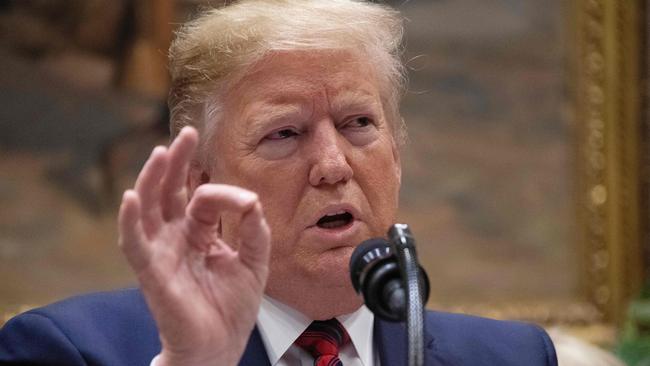
Scepticism grew in some US quarters when China, in the US view, started to renege on agreed-upon provisions in the days before last week’s talks began. Mr Lighthizer in particular saw China “moving the goalposts” on certain details just as an agreement appeared within reach, according to White House officials.
Chinese negotiators let their US counterparts know that they had serious reservations with the text. The Chinese were no longer willing to commit to changing laws covering intellectual property, forced technology transfer, subsidies and other issues at the heart of the dispute. They also objected to publication of all the details of the text, preferring a summary.
To the Chinese, this was a matter of honour: The US should trust Beijing to make the changes they said they would make, even if that meant changing regulations rather than laws. Besides, the US was being unfair in refusing, upon the signing of a deal, to remove tariffs that had been assessed in the year-long fight, the Chinese believed.
“There is a real desire on our end to keep the tariffs on,” one White House official said. “That is a sticking point.”
Another major area of conflict has been how to deal with what the US sees as Chinese recalcitrance on clamping down on the theft of US intellectual property, said people briefed on the talks. The US initially had sought to appeal to Mr Xi’s nationalistic tendencies, arguing that if China was as great as Mr Xi portrayed it, why would it need to steal US technology?
The Trump administration believed it had an agreement that included a satisfactory level of enforcement should the Chinese record not improve. “Not tiger teeth, but real enough to make a deal,” one of the people tracking the talks said.
Then Chinese officials said enforcement procedures would need to go through Chinese law-enforcement channels and couldn’t be guaranteed at the negotiating table, this person said, which US officials didn’t view as a credible option.
In Beijing, as the talks approached, Chinese officials believed they had some leverage, The Wall Street Journal has previously reported, because they saw Mr Trump’s public criticism of the Federal Reserve and his desire for lower interest rates as a sign that he was worried about the future course of the US economy and therefore may be more eager to do a deal. It was a miscalculation on their part; Mr Trump has long called for low borrowing costs and also has repeatedly cited the enduring strength of the US economy.
President Xi also was encouraged by a pick-up in Chinese growth -- the result of Beijing’s aggressive stimulus policies -- and by a perception that the American economy is about to enter a down cycle. “Time is on our side,” said a senior official in Beijing. On the home front, Mr Xi is wary of a potential political backlash as a result of any perception that he is conceding too much to Washington.
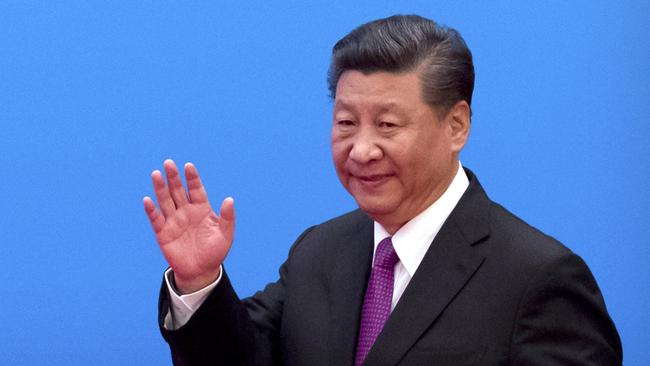
Chinese officials were therefore caught off guard, three days before the Washington talks were scheduled, when Mr Trump said on Twitter he would increase tariffs, to 25 per cent from 10 per cent, on the $US200 billion in Chinese goods because he saw the Chinese backtracking -- the original threat he had set for a March 1 deadline.
He also said he would start the legal proceedings necessary to add tariffs to almost everything else the Chinese sold in the US, even if it meant the Chinese cancelled their Washington visit.
A similar move by Mr Trump in September -- when he first went ahead with the tariffs on $US200 billion in goods -- had led to a cancellation of talks and put negotiations in a deep freeze until the dinner December 1 in Buenos Aires.
Shortly after Mr Trump’s announcement of the tariff increase, Beijing’s trade negotiators, who had booked Air China tickets to Washington, received an urgent order: Stay put until further notice. “Looks like we’re not going,” one of them said early Monday morning.
Up until that moment, China’s leadership had expected the trip to bring months of negotiations to a close, according to Chinese officials close to the negotiation process, given that Chinese diplomats were already in discussion with their American counterparts about a possible summit between Messrs Xi and Trump to finalise a trade agreement.
Now, the pressing question for Beijing became: Should it pull out of the planned talks to adhere to its longstanding public position that China doesn’t negotiate under threat? Or should China bite the bullet and still send the delegation to avoid a complete collapse of negotiations?
The Chinese side wanted more information from Washington before making the decision. But senior officials knew news of Mr Trump’s tweets would inevitably cause market anxiety. The first order of business Monday morning: China’s central bank sped up a plan to release more funds for banks, a stimulus measure aimed at calming jittery investors and businesses.
State-backed funds were also instructed to buy what was necessary to prevent a free fall of shares. China’s Foreign Ministry spokesman released a statement at Monday’s regular press briefing that said only that the Chinese delegation was “preparing to travel to the US” The spokesman didn’t say when the team would depart or give additional details.
On Tuesday morning, a group of officials at the vice minister level, including Liao Min, a trusted aide to Mr Liu and a vice Finance Minister, and Wang Shouwen, a vice Commerce Minister, reached the conclusion the talks should proceed, a position endorsed by Mr Xi though expectations of a positive result had fallen sharply.
The US side made some calls that turned off the Chinese, too. By insisting that it wouldn’t remove any tariffs upon closing a deal, the US gave Beijing little incentive to accept tough conditions. The US position remained firm: no tariff removal until Beijing showed it would carry through on the commitments it made under the deal. On top of that, the US wanted China to pledge not to retaliate if the US were to reimpose tariffs if it found China in violation of some provisions.
Mr. Trump on Thursday let it be known he didn’t want the US to appear soft on China, according to one person briefed on the matter.
The two days of negotiations went amicably nonetheless, according to people tracking the talks. Messrs Lighthizer and Mnuchin, who both were in the discussions, took Mr Liu to a working dinner at the Metropolitan Club, a ritzy private club near the U.S. Trade Representative’s headquarters that is a Lighthizer favourite. Mr Liu continued the talks on Friday despite the US implementing the higher tariffs very early Friday morning.
Later that morning, Mr Lighthizer greeted the Chinese envoy at the door of the USTR office -- a gesture he rarely makes, but one which he could be sure would be captured by photographers and camera crews waiting outside.
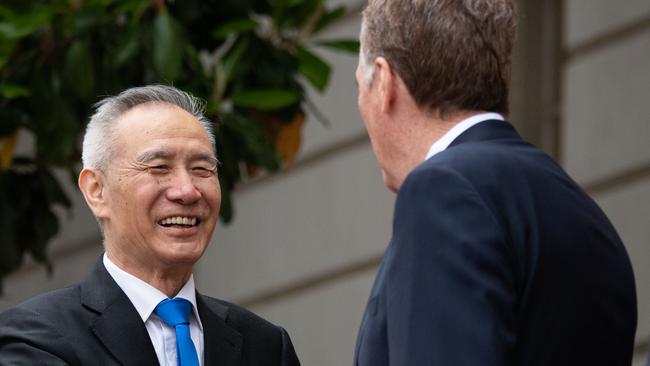
By then, though, the US team went into the talks not expecting to do a deal, figuring they would have a “non-meeting,” according to one person briefed on the discussions. US officials at least wanted to make sure they didn’t leave with a complete break. The goal of the meeting was to be able to say the US negotiators were still trying, this person said.
In an interview with Chinese media Friday, Mr Liu disputed US accounts that China reneged on commitments it had already made as part of the trade talks. “We are very clear that we cannot make concessions on matters of principle,” Mr Liu said. “We hope our US colleagues understand this.”
In a commentary Saturday, the official People’s Daily said the text of any trade agreement “must be balanced and expressed in a way that is acceptable to the Chinese people and does not undermine the country’s sovereignty and dignity.”
With a deal now in limbo, with no formal plan to resume, the key to future developments may be in the hands of Mr Trump and Mr Xi. Each of the leaders has emphasised their personal rapport through the dispute. Mr Xi sent Mr Trump a letter as last week’s talks began, saying, according to Mr Trump, “Let’s work together, let’s see if we can get something done.”
Mr Trump after the talks ended Friday said on Twitter: “The relationship between President Xi and myself remains a very strong one, and conversations into the future will continue.” He added tariffs “may or may not be removed depending on what happens with respect to future negotiations!”
“At this point, it seems that the only way to break the impasse is through direct dialogue between the two leaders,” said one Beijing official.
The two leaders are expected to meet at the G-20 meeting at the end of June, if they don’t meet earlier. After Mr Liu jetted off back to Beijing, Mr Lighthizer released a statement saying that on Monday USTR would “begin the process of raising tariffs on essentially all remaining imports from China.”
Wall Street Journal




To join the conversation, please log in. Don't have an account? Register
Join the conversation, you are commenting as Logout